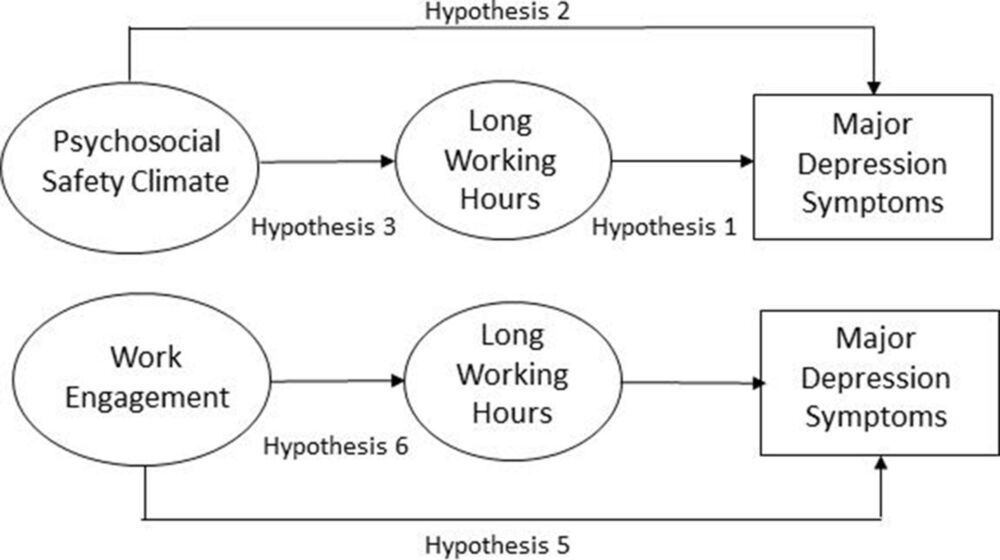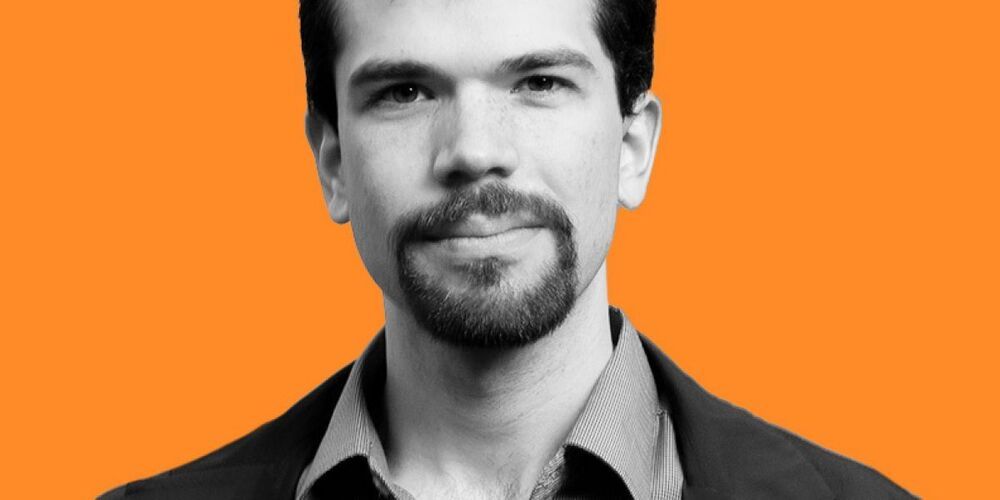Mesobot can track squid, jellyfish, and other deep-sea creatures for up to a day at a time.
Category: climatology – Page 124

Predicting new major depression symptoms from long working hours, psychosocial safety climate and work engagement: a population-based cohort study
Objectives This study sought to assess the association between long working hours, psychosocial safety climate (PSC), work engagement (WE) and new major depression symptoms emerging over the next 12 months. PSC is the work climate supporting workplace psychological health.
Setting Australian prospective cohort population data from the states of New South Wales, Western Australia and South Australia.
Participants At Time 1, there were 3921 respondents in the sample. Self-employed, casual temporary, unclassified, those with working hours 35 (37% of 2850) and participants with major depression symptoms at Time 1 (6.7% of 1782) were removed. The final sample was a population-based cohort of 1084 full-time Australian employees.


Big oil and gas kept a dirty secret for decades. Now they may pay the price
Almost all the lawsuits draw on the oil industry’s own records as the foundation for claims that it covered up the growing threat to life caused by its products.
Shell, like other oil companies, had decades to prepare for those consequences after it was forewarned by its own research. In 1958, one of its executives, Charles Jones, presented a paper to the industry’s trade group, the American Petroleum Institute (API), warning about increased carbon emissions from car exhaust. Other research followed through the 1960s, leading a White House advisory committee to express concern at measurable and perhaps marked changes in climate by 2000.
With an unprecedented wave of lawsuits, America’s petroleum giants face a reckoning for the environmental devastation caused by fossil fuels – and covering up what they knew along the way.

Synthetic tree enhances solar steam generation for harvesting drinking water
About 2.2 billion people globally lack reliable access to clean drinking water, according to the United Nations, and the growing impacts of climate change are likely to worsen this reality.
Solar steam generation (SSG) has emerged as a promising renewable energy technology for water harvesting, desalination, and purification that could benefit people who need it most in remote communities, disaster-relief areas, and developing nations. In Applied Physics Letters, Virginia Tech researchers developed a synthetic tree to enhance SSG.
SSG turns solar energy into heat. Water from a storage tank continuously wicks up small, floating porous columns. Once water reaches the layer of photothermal material, it evaporates, and the steam is condensed into drinking water.

Helion Energy Achieves 100 Million Degrees Celsius Fusion Fuel Temperature and Confirms 16-Month Continuous Operation of Its Fusion Generator Prototype
REDMOND, Wash.—(BUSINESS WIRE)—Helion Energy (Helion), a clean electricity company committed to creating a new era of clean energy through fusion, today became the first private company to announce exceeding 100 million degrees Celsius in their 6th fusion generator prototype, Trenta. Reaching this temperature is a critical engineering milestone as it is considered the ideal fuel temperature at which a commercial power plant would need to operate. Helion will be presenting these operational results at the 63rd Annual Meeting of the APS Division of Plasma Physics. See abstract below.
“These achievements represent breakthroughs with major implications for how the world meets its expanding future electricity needs while dramatically reducing climate impact on a relevant timescale” Tweet this
Helion also announced their Trenta prototype recently completed a 16-month testing campaign, which pushed fusion fuel performance to unprecedented levels and performed lifetime and reliability testing on key components of the fusion system. Helion will be presenting these results at the 2021 IEEE Pulsed Power Conference & Symposium on Fusion Engineering. See abstract below.


Quantum computers are already detangling natures mysteries
As the number of qubits in early quantum computers increases, their creators are opening up access via the cloud. IBM has its IBM Q network, for instance, while Microsoft has integrated quantum devices into its Azure cloud-computing platform. By combining these platforms with quantum-inspired optimisation algorithms and variable quantum algorithms, researchers could start to see some early benefits of quantum computing in the fields of chemistry and biology within the next few years. In time, Google’s Sergio Boixo hopes that quantum computers will be able to tackle some of the existential crises facing our planet. “Climate change is an energy problem – energy is a physical, chemical process,” he says.
“Maybe if we build the tools that allow the simulations to be done, we can construct a new industrial revolution that will hopefully be a more efficient use of energy.” But eventually, the area where quantum computers might have the biggest impact is in quantum physics itself.
The Large Hadron Collider, the world’s largest particle accelerator, collects about 300 gigabytes of data a second as it smashes protons together to try and unlock the fundamental secrets of the universe. To analyse it requires huge amounts of computing power – right now it’s split across 170 data centres in 42 countries. Some scientists at CERN – the European Organisation for Nuclear Research – hope quantum computers could help speed up the analysis of data by enabling them to run more accurate simulations before conducting real-world tests. They’re starting to develop algorithms and models that will help them harness the power of quantum computers when the devices get good enough to help.
How mirrors could power the planet… and prevent wars
Concentrated solar power might just revolutionize the energy sector as we know it.
Subscribe here: http://freeth.ink/youtube-subscribe-concentratedsolarpower.
Concentrated solar power is produced using a large amount of mirrors which are angled to reflect the sunlight onto a large solar receiver. Aside from being clean energy, one of the most promising advantages of CSP is that it can generate transportable energy for use far beyond where it was harvested.
The idea of concentrated solar power isn’t new — the first commercial plant was developed in the 1960s. But a company called Heliogen has found a way to make the process of reflecting and storing sunlight much more accurate and efficient. And soon, it might be more cost-effective than fossil fuels.
If adopted globally, this could lead to a hard reset in the manufacturing industry, not to mention prevent wars over oil and mitigate climate change.
See the full article on concentrated solar power and Heliogen here: https://www.freethink.com/shows/hard-reset/concentrated-solar-power.
Exoskeleton | Ballistic Helmet | Military Suits
✅ Instagram: https://www.instagram.com/pro_robots.
You are on the Pro Robot channel and today we are going to talk about the soldiers of the future. Exoskeletons, ballistic helmets, military suits, chips and more are already being introduced into the armaments of different countries. In this issue we will find out what the super-soldier of the future will be like and what developments are being conducted in the military industry. Watch the video to the end and write your opinion in the comments: will robots replace humans in military service?
0:00 In this video.
0:30 Combat glasses.
2:26 Devtac Ronin Kevlar ballistic helmet.
3:00 STILE smart fabric.
3:42 Stealth Cloak.
4:10 Future Soldier System Full Suit.
5:15 Sotnik Suit.
5:55 Exoskeleton Military.
6:32 PowerWalk current generator exoskeletons.
7:00 Human Universal Load Carrier exoskeleton with hydraulic drive.
7:24 A Flying Suit for Military.
7:48 Jetpack.
8:09 Invasive chips and genetic engineering.
9:02 Man-Made Lightning.
More interesting and useful content:
✅ Elon Musk Innovation https://www.youtube.com/playlist?list=PLcyYMmVvkTuQ-8LO6CwGWbSCpWI2jJqCQ
✅Future Technologies Reviews https://www.youtube.com/playlist?list=PLcyYMmVvkTuTgL98RdT8-z-9a2CGeoBQF
✅ Technology news.
#prorobots #technology #roboticsnews.